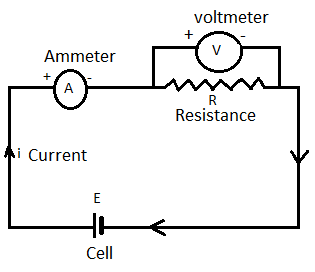
An ammeter and a voltmeter are connected in series to a battery with an emf $e = 6.0V$. When a certain resistance is connected in parallel with the voltmeter , the reading of the voltmeter decreases $2.0$ times , whereas the reading of the ammeter increases the same number of times. Find the voltmeter reading after the connection of the resistance.
A. $2V$
B. $4V$
C. $8V$
D. $18V$
Answer
576.6k+ views
Hint: We studied current electricity, in this type of question we use the basic concept of an ammeter and voltmeter. Both the ammeter and the voltmeter are connected in the current carrying circuit for measurement of the current and voltage respectively.
Complete step by step answer:
When the current follows through there is a potential difference between the two points in the electrical circuit, this potential difference is measured by a voltmeter and then an ammeter is used to measure the electric current. For measuring the current and the voltage, these devices are connected series and parallel with the measuring device respectively. A standard voltmeter and ammeter alter the circuit's measurements due to withdrawing of some extra current and by decreasing the current flow respectively.
In the given question, An ammeter and a voltmeter are connected in series to a battery with an emf $e = 6.0V$. Initially, only the resistance of ammeter is presents i.e. $R$ and the voltage drop occurs only in voltmeter i.e. $V$. Hence,
$V = 6 - iR$, where $i$ is current in circuit.
$i = \dfrac{{6 - V}}{R}$
When a certain resistance is connected in parallel with the voltmeter , the reading of the voltmeter decreases $2.0$ times , whereas the reading of the ammeter increases the same number of times. So,

$
{V_f} = V/2,{i_f} = 2i \\
{V_f} = 6 - {i_f}R \\
V/2 = 6 - 2iR \\
$
After putting the value of current,
$
\dfrac{V}{2} = 6 - 2R(\dfrac{{6 - V}}{R}) \\
V = 2(2V - 6) \\
V = 4V - 12 \\
V = 4 \\
$
The voltmeter reading after the connection of the resistance 4 volt.
So, the correct answer is “Option B”.
Note:
Ammeter has low resistance and the voltmeter has high internal resistance. For the ideal ammeter, resistance is zero. If the resistance of the ammeter is high it will alter the measurements of the flowing current that is why it should be low.
Complete step by step answer:
When the current follows through there is a potential difference between the two points in the electrical circuit, this potential difference is measured by a voltmeter and then an ammeter is used to measure the electric current. For measuring the current and the voltage, these devices are connected series and parallel with the measuring device respectively. A standard voltmeter and ammeter alter the circuit's measurements due to withdrawing of some extra current and by decreasing the current flow respectively.
In the given question, An ammeter and a voltmeter are connected in series to a battery with an emf $e = 6.0V$. Initially, only the resistance of ammeter is presents i.e. $R$ and the voltage drop occurs only in voltmeter i.e. $V$. Hence,
$V = 6 - iR$, where $i$ is current in circuit.
$i = \dfrac{{6 - V}}{R}$
When a certain resistance is connected in parallel with the voltmeter , the reading of the voltmeter decreases $2.0$ times , whereas the reading of the ammeter increases the same number of times. So,

$
{V_f} = V/2,{i_f} = 2i \\
{V_f} = 6 - {i_f}R \\
V/2 = 6 - 2iR \\
$
After putting the value of current,
$
\dfrac{V}{2} = 6 - 2R(\dfrac{{6 - V}}{R}) \\
V = 2(2V - 6) \\
V = 4V - 12 \\
V = 4 \\
$
The voltmeter reading after the connection of the resistance 4 volt.
So, the correct answer is “Option B”.
Note:
Ammeter has low resistance and the voltmeter has high internal resistance. For the ideal ammeter, resistance is zero. If the resistance of the ammeter is high it will alter the measurements of the flowing current that is why it should be low.
Recently Updated Pages
A man running at a speed 5 ms is viewed in the side class 12 physics CBSE

The number of solutions in x in 02pi for which sqrt class 12 maths CBSE

State and explain Hardy Weinbergs Principle class 12 biology CBSE

Write any two methods of preparation of phenol Give class 12 chemistry CBSE

Which of the following statements is wrong a Amnion class 12 biology CBSE

Differentiate between action potential and resting class 12 biology CBSE

Trending doubts
What are the major means of transport Explain each class 12 social science CBSE

Which are the Top 10 Largest Countries of the World?

Draw a labelled sketch of the human eye class 12 physics CBSE

Explain sex determination in humans with line diag class 12 biology CBSE

Explain sex determination in humans with the help of class 12 biology CBSE

Differentiate between homogeneous and heterogeneous class 12 chemistry CBSE




